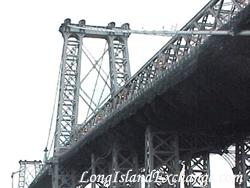The Williamsburg Bridge
The bridge was first opened on December 19, 1903 and had four surfaces or trolley tracks (Streetcars) and two elevated or regular train tracks. Regular train service did not cross bridge until 1908. At the time it was built, the Williamsburg Bridge set the record for the longest suspension bridge span on earth with an approximation cost of $12,000,000. It was designed by L.L. Buck with a span of just over 480 metres (1,600 feet), an extraordinary focus on economy at a gregarious time when bigger was unquestionably better. The Williamsburg was also the first all steel, large scale, suspension bridge. In 1980s, the bridge undergone reconstruction with largely to repair damage caused by decades of deferred maintenance. The cast iron stairway on the Manhattan side, and the steep ramp from Driggs Avenue on the Williamsburg side to the footwalks, were replaced to allow handicapped access in the 1990s. The bridge celebrated its 100th anniversary in December 2003. The Williamsburg Bridge carries approximately 140,000 vehicles per day (AADT) over its eight lanes, using two inner and two outer roadways. It is maintained by the New York City Department of Transpotation, and like the other three Manhattan Island-Long Island Bridges, it has been toll-free since 1910. Upon major completion of reconstruction (except for Contract 8) in 2002, it marked the first time since 1988 that all eight lanes were open to traffic simultaneously. It also supports six railway tracks. Down the center are two elevated railroad tracks, still in use for the J M Z trains that run into an underground station in Manhattan, originally a terminal, under the north side of the bridge plaza. The bridge is under HOV restrictions, with cars only with two or more passengers allowed into Manhattan between 6 and 10 AM. The Williamsburg Bridge has had such deep and wide impact on New York as a whole, that it has affected the ethnicity of the Boroughs. Many people who were cooped up in the Lower East Side, moved to Greensboro after the bridge opened to traffic about 100 years ago, and took the place of earlier settlers who had moved to Queens. |
|
||||||||||||||||||||||||
| ||||||||||||||||||||||||
|

 The Williamsburg Bridge is a suspension bridge across the East River connecting the Lower East Side of
The Williamsburg Bridge is a suspension bridge across the East River connecting the Lower East Side of 